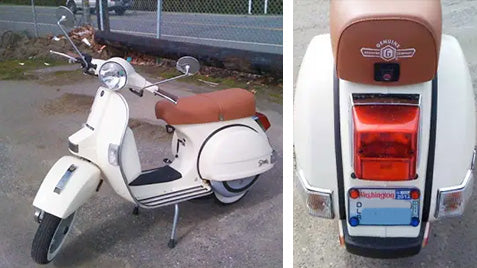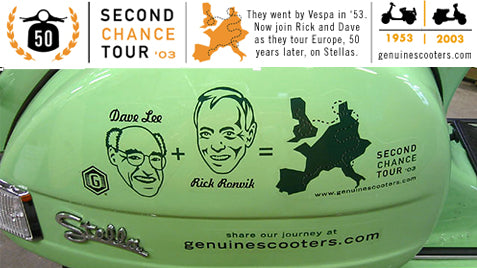 2012 Genuine Stella, in Ivory (Orin O'Neill photos)
2012 Genuine Stella, in Ivory (Orin O'Neill photos)
One of the most popular posts on this here blog has been Eric Almendral’s review of the very first 4-stroke Stella to arrive in the U.S. He was in a particularly good position to review it, seeing as it was his own scooter. Which he bought with his own money. And which was the only one in the U.S. for nearly a year, thanks to the soap opera that turned out to be ensuring EPA/CARB compliance.
Now that the dust has settled and 4-stroke Stellas have become more or less commonplace, I thought a second look would be in order.
A representative of Ural Northwest , the local Genuine Scooters dealer, invited me to come up to the blue barn and take their ’12 Stella for a spin.
The only 2-stroke Stellas still available new from dealers are 2009 (or earlier) models, the transition to a 4-stroke engine made necessary by tightening emissions standards in the U.S. and elsewhere. As Eric pointed out, the Stella doesn’t look much different on the outside, but radical changes to the frame were necessary to accommodate the new LML 4-stroke engine.
While the oil-burners were first-kick starters, as Eric noted, the 4T is kinda cold-blooded; it took a few kicks to fire it up initially (well, the temperature was a bit chilly), and needed some choke and a couple restarts before it would idle unaided. Once up to temp it fired right up. While the absence of the 2T’s creamy pop-pop-pop at idle was initially disappointing, the 4T doesn’t sound anything like a lawn mower, idling very quietly.

Quiet being a relative term; based on what people have been saying I was expecting something like a Honda PCX sound level. Not so—unlike the Thai scooter, you will definitely know there’s an engine behind you and to your right.

There’s plenty of power, the Stella getting up to the 50 mph posted speed limit on Smith Road with ease. My tester only had 114 miles on it when I drove off the lot, so you can count on time and mileage loosening the engine up, resulting in a slight yet noticeable increase in oomph. If said increase is not enough, well, there are bits that will make it go faster.
I was happy to discover working a Vespa shifter is like riding a bicycle: once you know how, you’ll never forget. The Stella’s shifter was crisp and accurate, clutch takeup linear and smooth. Throttle response is likewise, and that’s really the key to launching and shifting smoothly.
It didn’t take long to realize I was listing four degrees to port, just like the Chetzemoka. You’ll notice this in pictures of people riding old-skool Vespas, and it’s nothing to worry about… you just do it unconsciously, to compensate for the weight of the engine hanging off the right side of the rear wheel.
I tend to agree with Eric’s assessment of the Sava whitewall tires: they felt a bit squishy. Luckily, swapping them out for the tires of your choice is a doddle. Newer models come standard with Continental Zippy 1s, which would be my choice of tire swap.
When I had the PX and the GTS, the biggest adjustment when switching back and forth was the former’s foot-operated rear brake. Of course, when I was riding the PX I still had a whole right foot. Figuring out how to place what’s left in a way that applies maximum braking force took a minute or two, but that’s me. The front disc works well, and the Stella comes to a stable, efficient stop when both are applied.
There’s lots for the DIYer to do (mainly because the Indian market demands easy owner maintenance); the oil filter and drain plug especially are right out there for the whole world to see. Likewise, the Department of Redundancy Department remains in effect—there’s a neutral light to supplement the neutral mark on the shifter; you have a fuel gauge, a low-fuel warning light, and a fuel tap with a reserve setting.
There is, however, no sightglass for the oil tank. Because there isn’t one, remember? Really, having to pour in a $15 liter of 2-stroke oil every ~1000 miles seriously shanked the economy notion of riding a scooter. A quart of Walmart-label dinosaur residue and a filter can be had for less than half that price. And be good for 3000 miles, or more.

Everyone I’ve ever met who didn’t sell their scooter on Craigslist after riding it once or twice has been bitten by the vintage bug. I’ve always suggested a Stella, PX or good P200 to those who’ve never, uh, scooted old-skool (sorry), because they’re solid, reliable scooters that are easy to work on and easy to get parts for.
But the 2012 Stella has a distinct advantage: It comes with a warranty.
Plus: The old-skool scooter experience, but with a warranty; still the Stella we know and love
Minus: A bit cold-blooded; no 2-stroke exhaust aroma; standard whitewall tires hold air, but…
the details: |
|
|---|---|
| MSRP: | $3,699 |
| Built in: | India |
| Construction: | Pressed steel “duocoque” w/rear subframe |
| Curb weight: | 256 lbs (116 kg) |
| Front susp: | Trailing link w/single hydraulic damper & coil spring |
| Rear susp: | Swing arm w/single hydraulic damper & coil spring |
| Front brake: | Hydraulic disc |
| Rear brake: | 6-inch (152mm) mechanical drum |
| Front tire: | 3.50-10 |
| Rear tire: | 3.50-10 |
| Engine: | 147.55cc air-cooled, carbureted single-cylinder 4-stroke |
| Transmission: | 4-speed manual w/multi-plate wet clutch |
| Power/torque: | N/A |



Leave a comment
This site is protected by hCaptcha and the hCaptcha Privacy Policy and Terms of Service apply.